In a business world focused on quick success, “Built to Last” by Jim Collins and Jerry Porras stands out for its emphasis on long-term thinking and enduring corporate excellence. Since its 1994 release, this work has shaped our understanding of what makes companies last. Its insights remain relevant today, offering guidance for organizations in a fast-paced marketplace.
Collins and Porras argue that visionary companies—those leading for decades—share core traits that set them apart. Based on six years of research, the book highlights principles for lasting success, focusing on both financial strength and resilient corporate cultures driven by core values.
Core Concepts
Built to Last introduces several key ideas that form the foundation of enduring, visionary companies:
- Clock Building, Not Time Telling: Focus on creating an organization that thrives beyond any single product, leader, or trend. Build systems that endure.
- Preserve the Core/Stimulate Progress: Stay true to your core values while constantly innovating and adapting to drive progress.
- Big Hairy Audacious Goals (BHAGs): Set bold, long-term goals that inspire and unify the organization.
- Cult-like Cultures: Foster a strong, distinctive culture that attracts people who share your values.
- Try a Lot of Stuff and Keep What Works: Embrace experimentation, learn from successes and failures, and scale what works.
- Home-Grown Management: Develop leaders from within to preserve culture and ensure continuity.
- “And” Thinking: Reject the false choice of “either/or.” Embrace seemingly contradictory forces simultaneously, like tradition and innovation.
Visionary companies endure by combining a timeless core ideology with relentless innovation, bold goals, and a culture that reinforces their values across generations.
Chapter-by-Chapter Review
Chapter 1: The Best of the Best
Collins and Porras introduce their research methodology and the concept of visionary companies. You’ll gain insights into what sets these extraordinary organizations apart from their competitors.
Chapter 2: Clock Building, Not Time Telling
This chapter emphasizes the importance of building adaptable, enduring organizations rather than relying on a single great idea or charismatic leader. You’ll learn why visionary companies focus on organizational strength over individual products or market opportunities.
Chapter 3: More Than Profits
Here, the authors explore how visionary companies are driven by a core ideology that goes beyond mere profit-making. You’ll discover the power of having a strong sense of purpose and core values.
Chapter 4: Preserve the Core / Stimulate Progress
This chapter introduces a key paradox of visionary companies: they maintain unchanging core values while relentlessly pushing for progress. You’ll learn strategies for balancing stability and change in your organization.
Chapter 5: Big Hairy Audacious Goals
Collins and Porras discuss the importance of setting ambitious, long-term goals. You’ll see how BHAGs can inspire and unite an organization, driving it towards greatness.
Chapter 6: Cult-like Cultures
This chapter explores how visionary companies create strong, distinctive cultures. You’ll gain insights into fostering an environment that attracts committed individuals who align with your organization’s values.
Chapter 7: Try a Lot of Stuff and Keep What Works
Here, you’ll learn about the power of experimentation and evolutionary progress. The authors show how visionary companies embrace trial and error, learning from both successes and failures.
Chapter 8: Home-grown Management
This chapter emphasizes the importance of developing leadership talent from within. You’ll discover why visionary companies rarely hire CEOs from outside their organizations.
Chapter 9: Good Enough Never Is
The final chapter explores how visionary companies maintain a relentless drive for improvement. You’ll learn about the mindset that pushes these organizations to continually surpass their own achievements.
Key Strengths
- Offers a research-based framework for building enduring, successful organizations
- Provides actionable insights applicable to businesses of various sizes and industries
- Challenges conventional wisdom about corporate success
- Includes compelling examples from a wide range of visionary companies
- Presents complex ideas in an accessible, engaging manner
Potential Drawbacks
- Some concepts may be challenging to implement in established organizational cultures
- The focus on large, long-standing companies may not fully resonate with startups or small businesses
- Some readers might find the amount of historical data and research overwhelming
Who This Book Is For
Built to Last is an invaluable resource for a wide range of readers, particularly:
- CEOs and senior executives looking to build enduring organizations
- Entrepreneurs aiming to create companies with lasting impact
- Business students and academics interested in organizational longevity and success
- Anyone fascinated by what makes great companies truly stand out
Final Review
Built to Last is a seminal work in business literature that continues to offer profound insights decades after its initial publication. Collins and Porras have created a book that is both intellectually rigorous and practically applicable, challenging readers to think differently about what it takes to build a truly great company.
The book’s strength lies in its comprehensive research and the timeless nature of its principles. While many business books focus on short-term strategies, Built to Last provides a framework for creating organizations that can thrive for generations. From the concept of preserving the core while stimulating progress to the power of BHAGs, the authors offer ideas that inspire a higher standard of corporate vision and performance.
While some readers may find the focus on large, established companies less relevant to their immediate context, the core principles are adaptable to organizations of various sizes and stages. Whether you’re leading a Fortune 500 company or launching a startup, Built to Last offers valuable lessons on how to create an organization that doesn’t just succeed in the short term, but endures and thrives over the long haul.
Rating: 4.5/5
A classic in business literature that provides a research-backed blueprint for building visionary companies, offering timeless principles for creating organizations that stand the test of time.

Alternative Books
If you found Built to Last insightful, here are three related books that further explore organizational excellence and leadership:

Good to Great by Jim Collins
A natural follow-up to Built to Last, exploring how good companies can become great ones.
Rating: 4.5/5

Start with Why by Simon Sinek
Delves into the importance of purpose in organizational success, complementing the core ideology concept in Built to Last.
Rating: 4.4/5

The 7 Habits of Highly Effective People by Stephen R. Covey
While focused on individual effectiveness, many principles align with building lasting organizations.
Rating: 4.6/5





